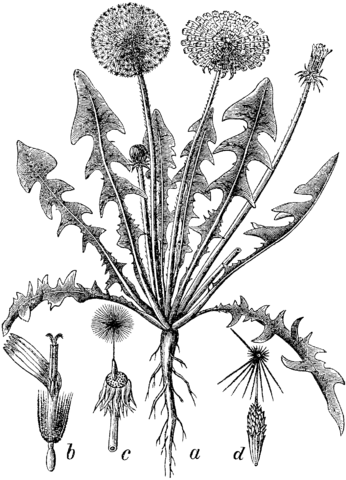What follows is a mediation sparked by the lectionary reading from Revelation 21:10,22-22:5 for this Sunday, Easter 6, Year C in the Revised  Common Lectionary
Common Lectionary
The dandelion has a tap root that goes three feet down, white and milky and strong–tear off the top and it will come back. It looks something like a lion’s fang and that is where the name comes from, lion-tooth in French: dent-de-lion.
Some call it a weed but why would you? A dandelion in the yard is a sign of health, that the acid balance is good, that clover and alfalfa and other nitrogen fixers will do well. Ehrenfried Pfeiffer in his book “Weeds and What They Tell” calls the dandelion a healer because it “transports the minerals, especially calcium, upward from the deeper layers, even from underneath the hardpan, which it penetrates, and depoists them nearer the surface.” Your grass with its shallow roots take advantage of this, the dandellion with its yellow flower is a kind of living fertilizer applicator to the soil–there is no call for RoundUp.
The long tap root is also a kind of elevator in the soil, making way deep down for earthworms to travel to the surface. When you have earthworms in abundance there is no need to till or plow–they will do that work for you, just scatter organic matter on the surface–grass clippings, dried leaves, the grounds of your coffee–and they will take it down into the dirt, traveling in ease on the dandelion root elevator. When the dandelion dies its leaves and stalk, full of nitrogen will be caried by the worms to feed the soil. It does not compete with the plants around it, it helps and feeds them.
It feeds butterflies and bees and moths as well, its yellow flower one of the earliest of spring. The dandelion is edible for humans as well, the leaves and root long used to heal the stomach and liver. The leaves make for a good and bitter salad, something like arugula but too common to be an “all the rage” green. The root can be used as a kind of coffee when roasted, a healthy drink that some say purifies the blood. Then there is the well known dandelion wine. The dandelion is used in Chinese and Separdic and Greek cuisine, but it can be found anywhere in the world–a common culinary possibility.
And then there is the irresistable joy of their fluffy seed heads, a temptation for children and adults alike, even those who mistakenly think they are spreading a “weed.” Who could reject such a gift? Why prod and pull and dig? Why spray poisons to keep healing and health away? That sadly is our sin. In Revelation, when the New Jerusalem comes, we are told that there will be a tree whose leaves are for the “healing of the nations.” In the dandelion we already have such salvation, if only we would accept it. Breath in the spirit and blow.











